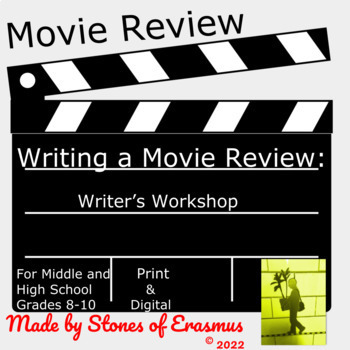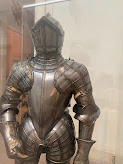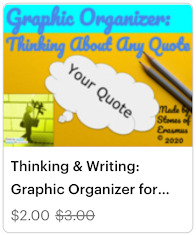 |
| "Harried Teacher" (Image Credit: Greig Roselli ©2024) |
Stones of Erasmus — Just plain good writing, teaching, thinking, doing, making, being, dreaming, seeing, feeling, building, creating, reading
30.11.24
Reflections of a Teacher: Navigating the Challenges of Education in 2024
 I am an educator and a writer. I was born in Louisiana and I now live in the Big Apple. My heart beats to the rhythm of "Ain't No Place to Pee on Mardi Gras Day". My style is of the hot sauce variety. I love philosophy sprinkles and a hot cup of café au lait.
I am an educator and a writer. I was born in Louisiana and I now live in the Big Apple. My heart beats to the rhythm of "Ain't No Place to Pee on Mardi Gras Day". My style is of the hot sauce variety. I love philosophy sprinkles and a hot cup of café au lait.
7.5.24
Navigating New Beginnings: Reflections on Teaching and Personal Growth in Jackson Heights
 |
| Jackson Heights in Queens is Aglow with May Flowers |
Approaching middle age-I'll be 45 in December-I feel confident yet exhausted, and curious about what's next. Maybe that curiosity is what's pushing me to explore a new direction. If Dante, in his classic epic, can find himself guided to new places, where he is "mid-life in his journey," then so can I?
Right? Listen!
I saw Jason and Corey again; this time, it was during lunch, where 1 sat with two very quiet, amazing teachers and about thirty loud teenagers. They had some stories to tell me-like, 'Remember that time you taught an entire lesson dressed up as Doctor Who?' or, 'When we were being rowdy, so you climbed on the table in your classroom to get our attention?' Yes, those anecdotes are most likely true. By nature, I am an ephemeral person; not much of what I do is permanent. Often feeling like a visitor in my own life, I am comforted when others can validate my experiences. For sure-my tombstone will not merely read
'Greig—he washed his dishes!'
 I am an educator and a writer. I was born in Louisiana and I now live in the Big Apple. My heart beats to the rhythm of "Ain't No Place to Pee on Mardi Gras Day". My style is of the hot sauce variety. I love philosophy sprinkles and a hot cup of café au lait.
I am an educator and a writer. I was born in Louisiana and I now live in the Big Apple. My heart beats to the rhythm of "Ain't No Place to Pee on Mardi Gras Day". My style is of the hot sauce variety. I love philosophy sprinkles and a hot cup of café au lait.
29.4.24
Fostering Textual Ownership: Passionate Teacher Explores Literacies & Strategies. Periodt. 📚
 I am an educator and a writer. I was born in Louisiana and I now live in the Big Apple. My heart beats to the rhythm of "Ain't No Place to Pee on Mardi Gras Day". My style is of the hot sauce variety. I love philosophy sprinkles and a hot cup of café au lait.
I am an educator and a writer. I was born in Louisiana and I now live in the Big Apple. My heart beats to the rhythm of "Ain't No Place to Pee on Mardi Gras Day". My style is of the hot sauce variety. I love philosophy sprinkles and a hot cup of café au lait.
12.3.24
Energize Students with Quick Activity: Critical Thinking & Movement for Engagement
Revitalize your classroom dynamics with an interactive activity that boosts student engagement and fosters critical thinking. Discover how positioning students based on their opinions on controversial topics like myths and relationships not only energizes them but also prompts insightful discussions on peer influence and the Socratic method. Suitable for grades seven and up. Share your experiences!
 I am an educator and a writer. I was born in Louisiana and I now live in the Big Apple. My heart beats to the rhythm of "Ain't No Place to Pee on Mardi Gras Day". My style is of the hot sauce variety. I love philosophy sprinkles and a hot cup of café au lait.
I am an educator and a writer. I was born in Louisiana and I now live in the Big Apple. My heart beats to the rhythm of "Ain't No Place to Pee on Mardi Gras Day". My style is of the hot sauce variety. I love philosophy sprinkles and a hot cup of café au lait.
2.3.24
Redefining Literacy in the AI Era: The Shift from Linear to Fragmented Reading
In this blog post, I discuss how literacy is evolving—a concept that has fascinated humanity since the advent of long-distance communication technologies such as the telegraph and telephone. Nowadays, our interaction with information is marked by its agility and rapidity, as demonstrated by AI advancements like ChatGPT from OpenAI.
 |
| Print magazines line a newsstand at the airport. |
 I am an educator and a writer. I was born in Louisiana and I now live in the Big Apple. My heart beats to the rhythm of "Ain't No Place to Pee on Mardi Gras Day". My style is of the hot sauce variety. I love philosophy sprinkles and a hot cup of café au lait.
I am an educator and a writer. I was born in Louisiana and I now live in the Big Apple. My heart beats to the rhythm of "Ain't No Place to Pee on Mardi Gras Day". My style is of the hot sauce variety. I love philosophy sprinkles and a hot cup of café au lait.
5.1.24
Things in My Type ‘B’ Classroom that just Makes Sense
 I am an educator and a writer. I was born in Louisiana and I now live in the Big Apple. My heart beats to the rhythm of "Ain't No Place to Pee on Mardi Gras Day". My style is of the hot sauce variety. I love philosophy sprinkles and a hot cup of café au lait.
I am an educator and a writer. I was born in Louisiana and I now live in the Big Apple. My heart beats to the rhythm of "Ain't No Place to Pee on Mardi Gras Day". My style is of the hot sauce variety. I love philosophy sprinkles and a hot cup of café au lait.
20.12.23
Medieval Majesty: Exploring the Intricacies of 11th Century Ivory Art at the Metropolitan Museum of Art
 I am an educator and a writer. I was born in Louisiana and I now live in the Big Apple. My heart beats to the rhythm of "Ain't No Place to Pee on Mardi Gras Day". My style is of the hot sauce variety. I love philosophy sprinkles and a hot cup of café au lait.
I am an educator and a writer. I was born in Louisiana and I now live in the Big Apple. My heart beats to the rhythm of "Ain't No Place to Pee on Mardi Gras Day". My style is of the hot sauce variety. I love philosophy sprinkles and a hot cup of café au lait.
🛡️ A Journey Through History at The Met’s Arms and Armor Gallery 🏰
 I am an educator and a writer. I was born in Louisiana and I now live in the Big Apple. My heart beats to the rhythm of "Ain't No Place to Pee on Mardi Gras Day". My style is of the hot sauce variety. I love philosophy sprinkles and a hot cup of café au lait.
I am an educator and a writer. I was born in Louisiana and I now live in the Big Apple. My heart beats to the rhythm of "Ain't No Place to Pee on Mardi Gras Day". My style is of the hot sauce variety. I love philosophy sprinkles and a hot cup of café au lait.
9.9.23
Unveiling Mythology to Teens: Insights from the Humanities Classroom
 | |
| Storm-Tossed and Star Crossed: Paris and Helen's Epic Journey to Troy |
 I am an educator and a writer. I was born in Louisiana and I now live in the Big Apple. My heart beats to the rhythm of "Ain't No Place to Pee on Mardi Gras Day". My style is of the hot sauce variety. I love philosophy sprinkles and a hot cup of café au lait.
I am an educator and a writer. I was born in Louisiana and I now live in the Big Apple. My heart beats to the rhythm of "Ain't No Place to Pee on Mardi Gras Day". My style is of the hot sauce variety. I love philosophy sprinkles and a hot cup of café au lait.
27.8.23
Unlock Your Learning Potential: 16 Essential Resources at Just $2 Each! 🌟
As the school year gets into full swing—or if you're like me, gearing up to start teaching right after Labor Day—the need for effective educational tools for our middle and high school students couldn't be more crucial.
In reviewing some of my most valued resources, I was thrilled to discover that 16 of them are available for just $2 each! Now that's a deal worth exploring!
Key Features:
- Easy-to-use — with printable PDFs and student-facing digital materials for each resource.
- Resources were all modified this Summer, ensuring up-to-date content.
Sharpen Your Analytical Skills
- Introduce resources aimed at analytical skills like:
- "Thinking & Writing: Graphic Organizer for Analyzing Quotes & Textual Evidence"
- "Opposing Viewpoints Debate: On Judging Appearances"
Master The Writing Process
- Focus on resources that target writing skills:
- "Detail Observation Guide: Enhance Narrative & Expository Writing"
- "Prewriting-Drafting-Revising: ELA Writing Cycle Guide"
Tools for Organized Learning
- Resources that help students stay organized:
- "Student Writing Presentation Toolbox for Middle & High School"
- "Student Writer's Portfolio Tracker: Organize & Showcase Work"
Multi-dimensional Writing
- Resources that help students explore different modes and purposes of writing:
- "Writing Modes: ELA Exercise for Improving Writing Skills"
- "Purpose & Mode in Writing: Comprehensive Chart for Student Success"
Boost Creative and Factual Writing
- Resources that offer brainstorming and research techniques:
- "Using Print & Non-Print Sources | Classroom Success for Writing"
- "Clustering Guide: Brainstorming Activity for ELA/Writing Students"
Reading for Success
- Encourage independent reading:
- "Teen Book List: Promoting Independent Reading for Grades 7-12"
Conclusion
Call to Action:
 I am an educator and a writer. I was born in Louisiana and I now live in the Big Apple. My heart beats to the rhythm of "Ain't No Place to Pee on Mardi Gras Day". My style is of the hot sauce variety. I love philosophy sprinkles and a hot cup of café au lait.
I am an educator and a writer. I was born in Louisiana and I now live in the Big Apple. My heart beats to the rhythm of "Ain't No Place to Pee on Mardi Gras Day". My style is of the hot sauce variety. I love philosophy sprinkles and a hot cup of café au lait.
17.8.23
Shaping Tomorrow's Citizens: Education, Religion, and Cultural Norms in the Classroom
In this blog post from Stones of Erasmus, I connect philosophical ideas with practical aspects of teaching and societal values. Let's invite reflection on the role of education, the influence of religion, and the importance of cultural norms in shaping the citizens of tomorrow.
 |
| The sun may appear small and lightbulb-like to the viewer, but it's actually a massive fusion-powered fireball that sustains life on Earth. |
Parity in the Classroom: The Common Gifts of Our Students
In every classroom, there lies a hidden world of potential. That gossipy student in the back row? Perhaps a budding playwright, weaving tales for the stage. Our students are not just learners; they are creators, thinkers, and future citizens.
The Personal Stance vs. The Professional Stance
Education is not just about imparting knowledge; it's a national effort to produce productive citizens. But what does that mean?
Producing productive citizens is about nurturing individuals who contribute positively to society and the economy. It's about fostering responsibility, hard work, and a commitment to the common good. It's about developing skills like problem-solving, communication, and teamwork that are vital in today's workforce.
The Image of Citizenship: A Reflection of Values
What should citizens of a country look like? The nineteenth-century image of the American family was a myth, yet it shaped perceptions. Today, we recognize that there is no one specific way citizens should look. Every individual is unique, bringing their own strengths and perspectives. The goal is to cultivate responsible, engaged members of society who contribute to the common good.
Religion and Education: A Complex Relationship
"Orderliness is godliness." This saying reflects how we often infuse public education with ideology, including the notion to "pull yourself up by your bootstrap." But do religious influences benefit the school system?
The Puritans were able to impose their ideology, but the relationship between religion and education is complex. Some believe that religious values can create moral grounding and community. Others see challenges in separating church and state, ensuring inclusivity for all students.
Folkways and Mores: The Fabric of Society
Folkways and mores are the threads that weave the social fabric. Folkways are the everyday customs and traditions, while mores are the deeper, moral values that guide a culture. Together, they shape our collective identity.
Opinions: The Personal Take on Knowledge
An opinion is more than a fleeting thought; it's your unique perspective on what you know. It's a reflection of your understanding, your beliefs, and your individuality.
 I am an educator and a writer. I was born in Louisiana and I now live in the Big Apple. My heart beats to the rhythm of "Ain't No Place to Pee on Mardi Gras Day". My style is of the hot sauce variety. I love philosophy sprinkles and a hot cup of café au lait.
I am an educator and a writer. I was born in Louisiana and I now live in the Big Apple. My heart beats to the rhythm of "Ain't No Place to Pee on Mardi Gras Day". My style is of the hot sauce variety. I love philosophy sprinkles and a hot cup of café au lait.
10.8.23
Tracking & Analyzing Myth Variations: A Comprehensive Guide to Using Graphic Organizers and Visual Aids in the Classroom
 I am an educator and a writer. I was born in Louisiana and I now live in the Big Apple. My heart beats to the rhythm of "Ain't No Place to Pee on Mardi Gras Day". My style is of the hot sauce variety. I love philosophy sprinkles and a hot cup of café au lait.
I am an educator and a writer. I was born in Louisiana and I now live in the Big Apple. My heart beats to the rhythm of "Ain't No Place to Pee on Mardi Gras Day". My style is of the hot sauce variety. I love philosophy sprinkles and a hot cup of café au lait.
21.7.23
Revitalizing High School Reading Programs: Diversifying Book Selections for Engaged Learning
 |
| Read and write for pleasure. |
 I am an educator and a writer. I was born in Louisiana and I now live in the Big Apple. My heart beats to the rhythm of "Ain't No Place to Pee on Mardi Gras Day". My style is of the hot sauce variety. I love philosophy sprinkles and a hot cup of café au lait.
I am an educator and a writer. I was born in Louisiana and I now live in the Big Apple. My heart beats to the rhythm of "Ain't No Place to Pee on Mardi Gras Day". My style is of the hot sauce variety. I love philosophy sprinkles and a hot cup of café au lait.
15.7.23
Writing a Movie Review: Writer's Workshop for Middle and High School Grades 8-10
Incorporating Movies into English Language Arts and Writing Instruction
 |
| Unlock English mastery! Transform your classroom with engaging movie reviews that boost language skills, critical thinking, and student participation. |
What's Included?
Teacher's Note for Using this Resource in the English and Writing Classroom: A helpful guide to ensure you get the most out of the resources provided.
Do's and Don'ts Anchor Chart: A visual guide to direct students on what to include and what to avoid in their movie review.
Fillable Movie Information Sheet for Before, During, and After Viewing: This allows students to track key information and impressions throughout the viewing experience, which helps build their review later.
Extended Written Response, Movie Quotes Double Entry Journal, Parts of a Movie Review Graphic Organizer: These tools support and scaffold students' writing, thinking, and reflection processes.
3 Exit Ticket Strategies for Formative Assessment: These will help you gauge student understanding and progress at the end of each lesson.
Movie Review Skills Assessment, 4-Point Grading Rubric, Student-Facing Checklist, and Grading Sheet: These tools help students self-assess their work and aid teachers in providing clear, fair, and consistent grading.
5-Star Rating and Rough Draft Starter: This provides students a starting point for their review and a simple, familiar way to give their overall rating.
Incorporating movie analysis into your curriculum can be a dynamic way to inspire student engagement and improve their English language and writing skills. By combining entertainment and education, you're teaching them language and skills like critical thinking, analysis, and self-expression.
Related Products
To further extend your resources, consider other products from Stones of Erasmus:
✰ Growing Humanities Bundle for Middle and High SchoolJoin me on this educational journey. Your feedback, comments, and insights are always welcome. Visit my website at stonesoferasmus.com for more resources and ideas.
© 2022-2023 Stones of Erasmus.
 I am an educator and a writer. I was born in Louisiana and I now live in the Big Apple. My heart beats to the rhythm of "Ain't No Place to Pee on Mardi Gras Day". My style is of the hot sauce variety. I love philosophy sprinkles and a hot cup of café au lait.
I am an educator and a writer. I was born in Louisiana and I now live in the Big Apple. My heart beats to the rhythm of "Ain't No Place to Pee on Mardi Gras Day". My style is of the hot sauce variety. I love philosophy sprinkles and a hot cup of café au lait.

 .
. 














